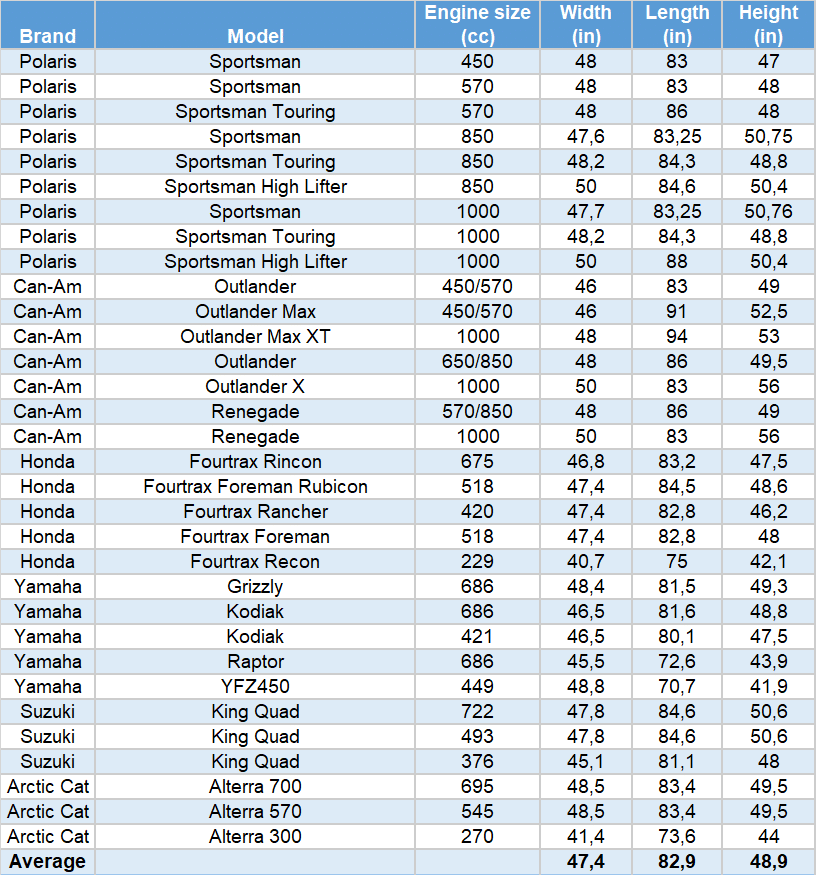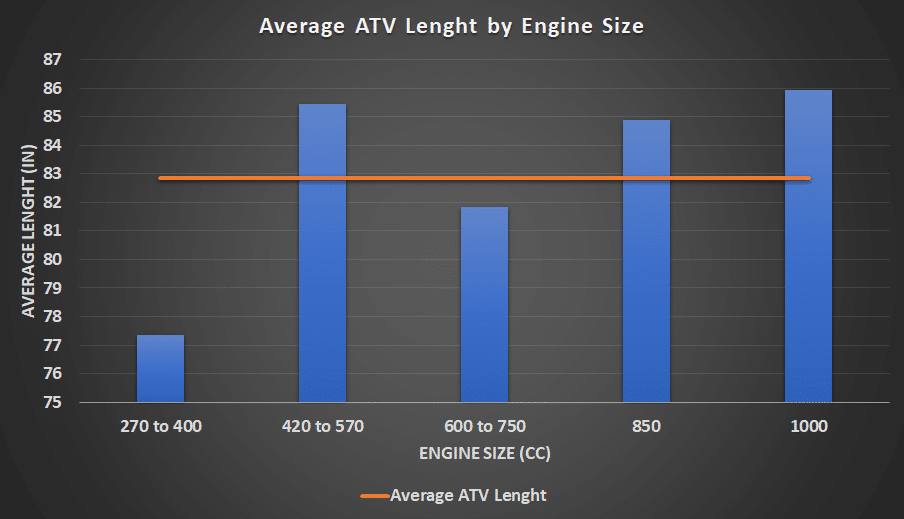This post looks at how wide, long, and tall ATVs are. ATVs vary quite a bit in size, often closely related to their engine size.
But by calculating an average for different engine sizes, I should be able to give you a pretty good idea of what to expect.
You might want to know how big an ATV is for several reasons. One of them is ensuring it fits on your trailer or truck bed.
Regardless of your reasons, I’ve done the job of collecting and processing the data for you.
Gathering the Data
To get reliable data, I looked up the spec sheets of every big ATV brand and almost all of their models.
Due to practical reasons, I could not include all available models, but most brands are well-represented.
Below are all the data I’ve collected, presented in a simple table form. All of the bikes listed are 2019 / 2020 models.
Comparing ATV Width
The width is usually the most critical measurement of an ATV. But before we look into why width is so important, let’s have a closer look at the numbers:
How wide is an ATV? Most ATVs are 45 to 50 inches (114-127cm) wide. The average ATV width is 47,4 inches (122,7cm). Modified ATVs with larger wheels, lift kits, or wheel spacers are even wider.
So if we look at the width of all major brands and all major ATVs models, we find that the average width is just over 47 inches.
To better visualize the differences in width between different ATV sizes, I’ve calculated the average width of the various engine sizes, as seen in the chart below.
From the stats, we can make a few interesting observations:
- ATV width is usually closely related to the ATV engine size. Smaller engines equal smaller widths, while a bigger engine usually means a broader vehicle.
- ATVs between 420 cc and 850 cc do not vary that much in width on average.
- The smallest engine sizes of ATVs (below 420cc) are much narrower than the average, while the biggest machines (1000 cc) are considerably wider.
Why does ATV Width Matter?
If you’ve never owned an ATV, it’s not always easy to understand how vital the machine’s width is. Let’s have a look at a few scenarios where width does matter.
When Riding ATV Trails That Have Width Restrictions
A significant number of ATV trails do not allow you to ride machines that are more than 50 inches wide.
If you ignore the regulations and ride an ATV wider than 50 inches, you do not only risk getting fined if you get caught. You may not even fit in the first place. The gates and bridges on such trails will often be built with the 50-inch limit in mind so that wider vehicles won’t fit.
This, however, is not an issue if you ride a stock ATV. All stock ATVs are 50 inches or narrower.
But the restrictions exclude most UTVs from riding these trails as they are typically above 50 inches wide. However, because of these regulations, more and more manufacturers are now offering even UTVs, that is just 50 inches wide.
When Riding in Dense Forests
ATV width matters not only when riding on man-made trails. The wider your ATV is, the more likely you will get stuck or not fit between trees and big rocks when riding in the forest.
When Transporting the ATV in a Trailer or Truck-Bed
As soon as you start modifying your ATV, such as installing tracks, wheel spacers, or bigger wheels, it will become wider and may no longer fit in your trailer or truck bed.
That’s why it’s always a good idea to measure how wide of an ATV you can fit before you purchase these upgrades if you may end up having to upgrade your means of transport as well.
When Riding Steep Hills or When Racing
A wider ATV is generally more stable than a more narrow machine. If you ride sideways on steep slopes, the extra stability of a wide machine may be just what you need to prevent you from tipping.
Or, if you do ATV racing, a wider wheelbase will allow you to tackle tight corners at higher speeds than you would with a more narrow setup.
How Can You Make an ATV Wider?
There are a few ways you can increase the width of an ATV.
Install Wheel Spacers
Installing wheel spacers is the fastest and cheapest way to achieve a wider wheel stance. While wheel spacers are helpful in some situations, they have a few significant downsides. Read this post to learn all about the pros and cons of installing wheel spacers on an ATV.
Install Different Rims
Something called the wheel offset is used to indicate how far from the wheel hub your tires sit. You will usually find this number stamped on the inside of your rim. The value may be negative, zero, or positive.
- A Zero offset is when the center of the wheel line up with the outside of the wheel hub.
- A negative offset is when the center of the wheel is inside the wheel hub surface.
- A positive offset is when the center of the wheel is outside the wheel hub surface.
To increase the width of an ATV, you can get rims with a larger offset. If your stock rims are negative five offset, getting rims with an offset of positive five will increase your ATV’s width by 20mm (10+10).
Related: ATV & UTV Wheel Offset: What It Is & How to Read
Get Bigger Tires
When you put bigger tires on your rims, your overall bike width will also increase. Increasing tire size by more than 1-2 inches will often result in rubbing issues.
To solve this, you may install wheel spacers, get rims with a different offset, or cut the plastic interfering with the wheels.
Related: Putting Bigger Tires on an ATV: All You Need to Know
Install a Lift Kit
A lift kit will not only make your ride higher, but it will also, in most cases, make the bike wider. This is necessary so you don’t ruin the ride’s stability by lifting its center of gravity.
Related: ATV Lift Kits: Weighing the Pros and Cons
Comparing ATV Length
Now that you know how wide the average ATV is, how long is an ATV? Most ATVs are 80 to 85 inches (203 – 216 cm) long. The average ATV length is 82,9 inches (211 cm). Touring ATVs are typically 5 – 10 inches longer than standard models.
Again I have calculated the average length of various ATV sizes and put them in a cha chart to compare.
This time the results may come across as a bit more surprising.
- There is no significant variation in ATV length when comparing the different sizes of engines from 420cc and up.
- I have included touring models, but no ones are available in the 600 -750 cc range. That’s why the average in this engine size range is lower.
Comparing ATV Height
Finally, we’ll have a look at the average ATV height.
How high is an ATV? Most ATVs are 46 to 52 inches (117 – 132 cm) tall. The average ATV height is 48,9 inches (124 cm). Hi-lift models are typically 1-3 inches higher than the standard model.
This time the comparison chart shows quite a different story.
- 420 – 850 cc ATVs are typically very similar in height.
- The average height of 1000cc ATVs is considerably higher than other engine sizes. This is partly due to many manufacturers offering high-lift editions of their 1000cc machines, a feature not always available with smaller engines.
Why Is ATV Height Important?
Increased height usually means better ground clearance and better off-road capabilities. The added height is also a great benefit when riding in deep mud. That’s why lift kits and larger wheels are popular upgrades for those who want to go deep mudding.
Related: 26 Essential ATV Mudding Mods.
A higher ride does, however, make the ATV more tippy. Stability is just as important as ground clearance if you do trail riding or utility work for the most part. The key is to find the ideal balance between height and stability for the riding you will be doing.
What About Weight?
In a previous post, I collected and compared the data on average ATV weight.
Related Questions
How wide is an ATV with tracks?
Installing tracks to your ATV will typically increase the width by 8-10 inches. ATV width with tracks is about 56 to 60 inches (142 – 152 cm).
How wide is an ATV trailer?

The width of ATV trailers varies, but they are typically about as wide as an average ATV, measuring between 48 to 50 inches. Ideally, the trailer should have about the same width as the ATV pulling it.
Wrapping Up
ATVs’ sizes can differ significantly, often influenced by their engine size. On average, ATVs typically measure 47.4 inches wide, 82.9 inches long, and 48.9 inches high.
The width significantly impacts trail access and forest riding, while modifications like lift kits can enhance off-road capabilities. However, consider transport implications and the balance between height and stability when customizing your ATV.




